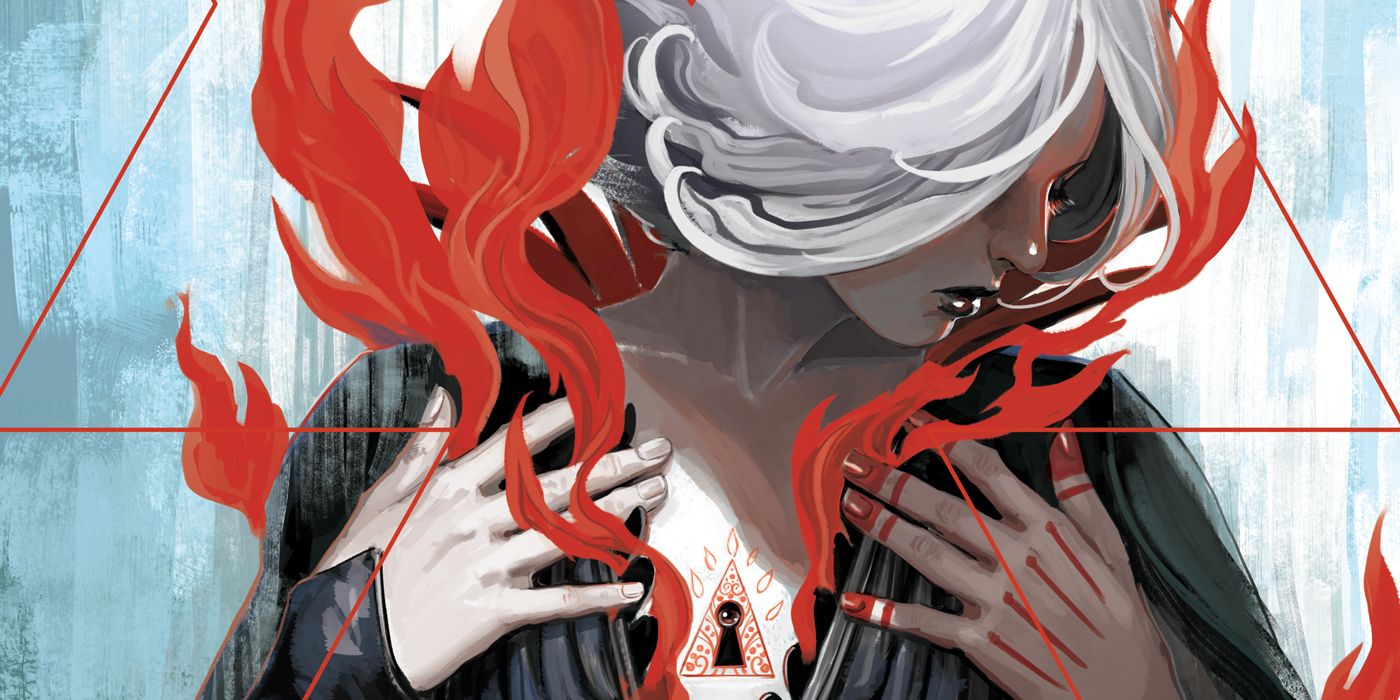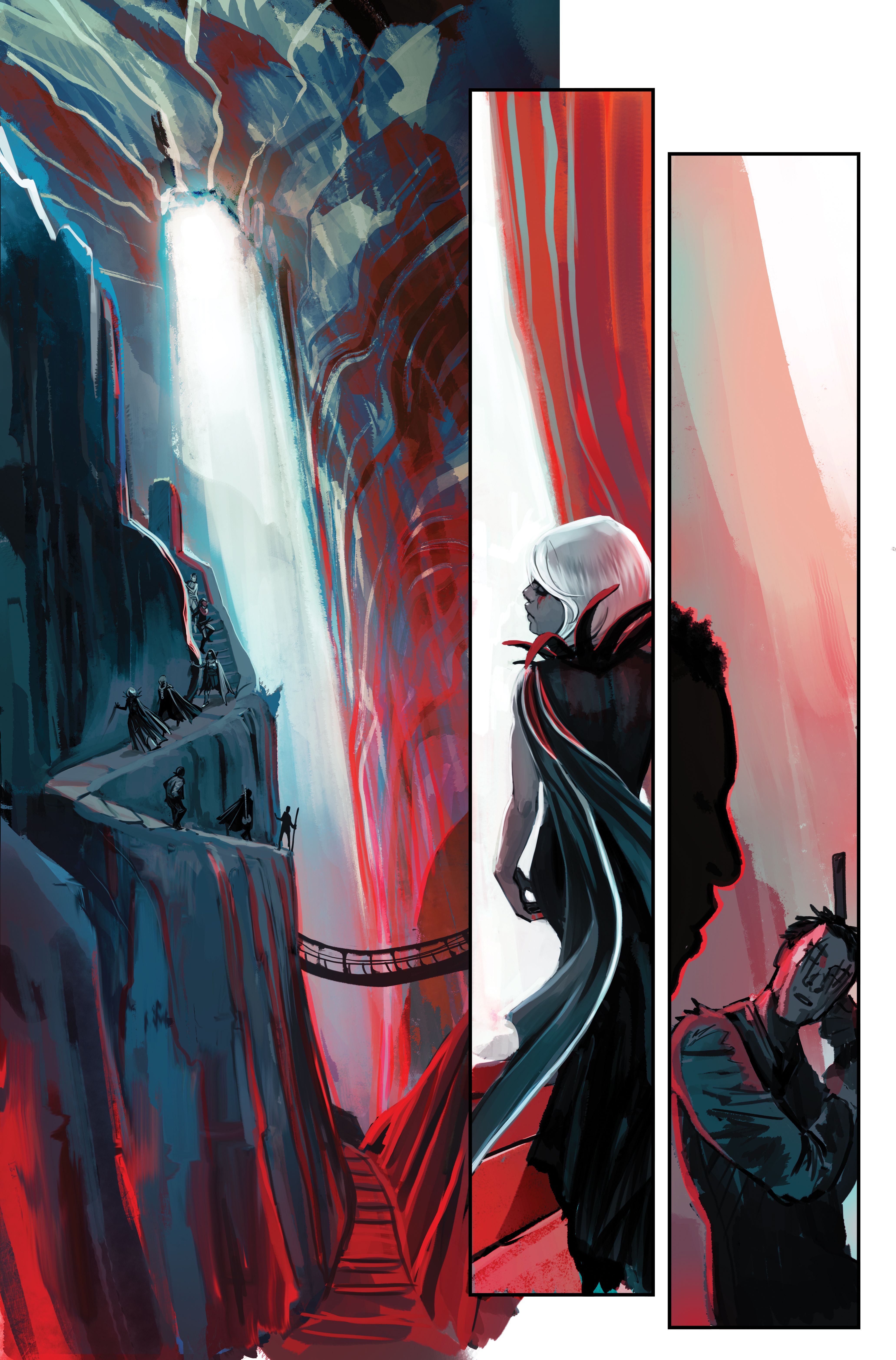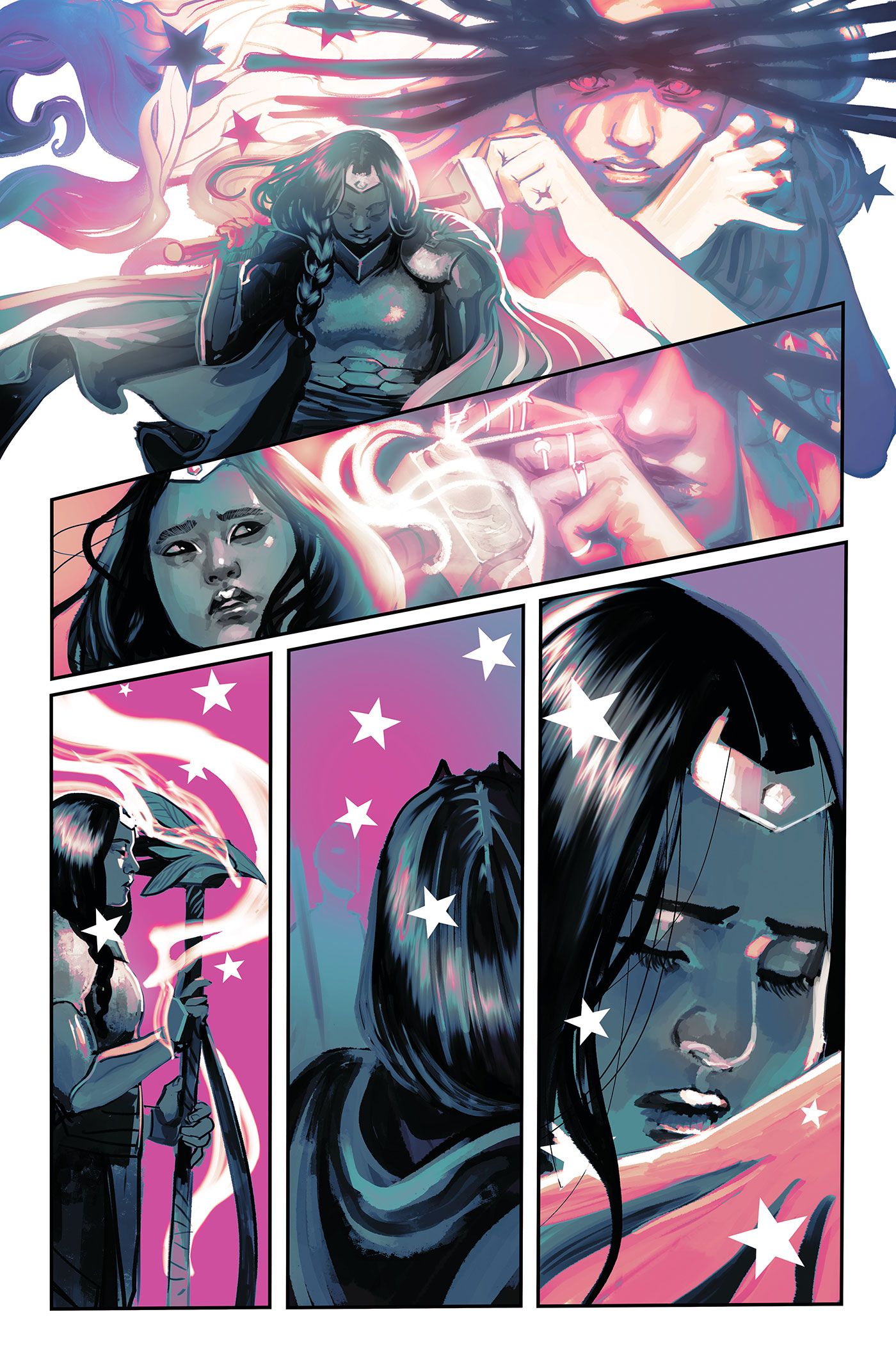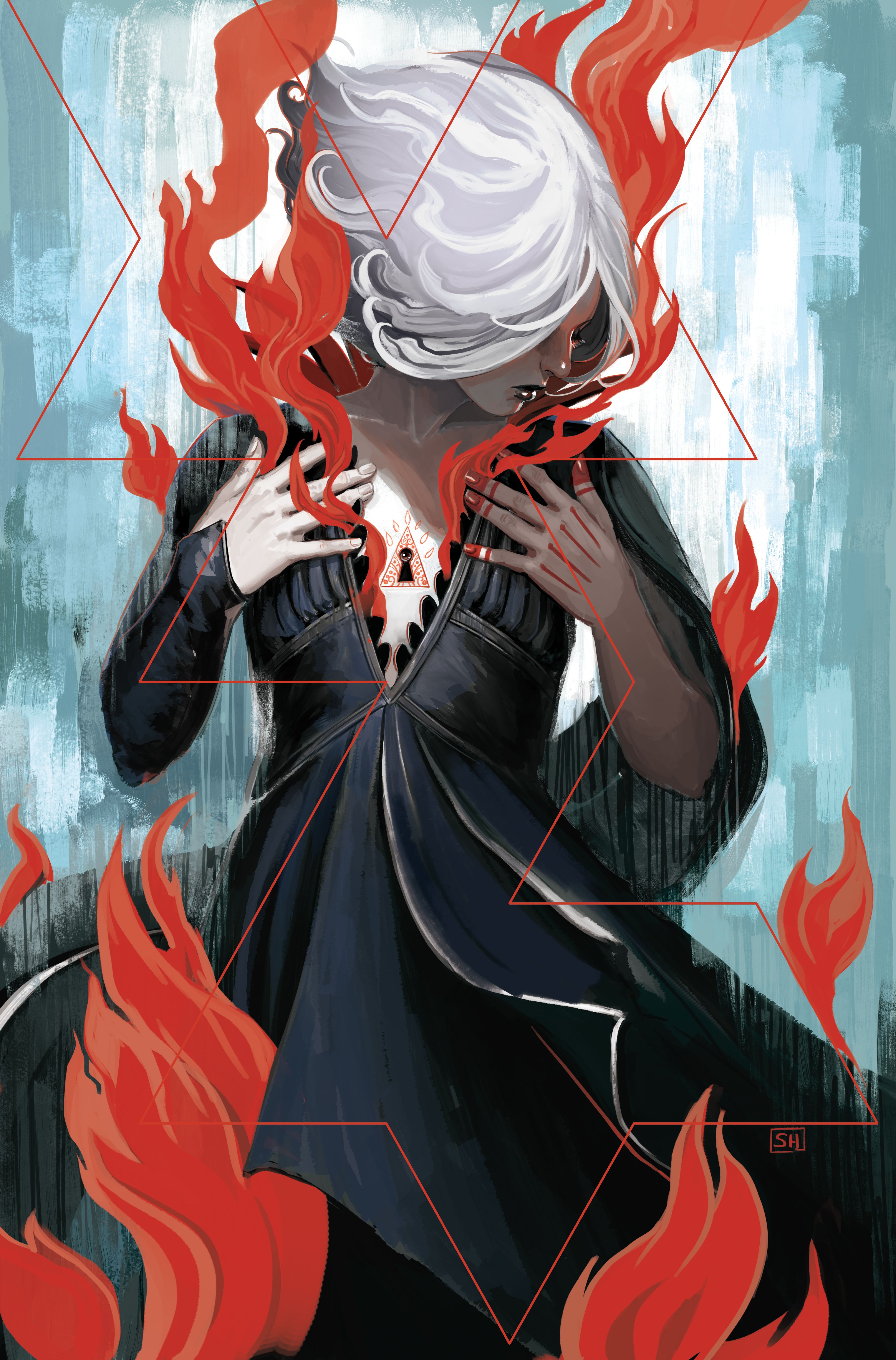Tabletop roleplaying games may be more popular than ever today, but what happens when a sinister entity preys upon players by transporting them to a world fraught with very real dangers and horrors? That's the premise of writer Kieron Gillen and artist Stephanie Hans creator-owned, fantasy-horror series, Die, from Image Comics. The British Fantasy Award-winning series follows the exploits of six 40- somethings forced to return to the titular world they narrowly escaped from as teenagers after inadvertently opening the door to it through one of their adolescent RPG sessions.
The fourth and final arc of Die, kicked off in Issue #16, which finds the cast finally delving into the darkness of the classic fantasy genre setting, the dungeon. In honor of the occasion, CBR spoke with Gillen about the current arc, working on the series, the chances for a sequel, and what the end of Die the comic means for the Gillen created Die RPG based on the series.
CBR: I've always viewed Die as both a horror and fantasy book, and it feels like the horror elements are coming to the fore with this final arc. Did you always envision this series as a horror comic?
Kieron Gillen: 'Where does fantasy end and horror begin?' is one of the questions at the heart of Die. This is absolutely a book about people's dreams, but of course, their dreams turn sour and become monstrous.
In terms of actual genre, the biggest initial influence on Die was Stephen King's It. This is a book about people who are now middle-aged, returning to a childhood horror. So its biggest influence is a horror book, but how we alter the mix as the story progresses is a key thing. There are definitely some bits where it feels more fantasy, and there are other bits where the horror comes right to the fore. You see that in a lot of roleplaying games anyway.
Die has also had plenty of sci-fi elements as well. So, would it be fair to say that as a whole it's kind of about the fantastic fiction that fuels RPGs?
It's not just fiction though. The idea of Die is it's a world composed of all the aspects that lead to the birth of D&D and the RPG – which is a lot more than just fiction. Even with the fiction, there's more to each region, for instance, the Lovecraft region [Seen in issue #16] isn't just Cthulhu, and the Lord of the Rings region isn't just Aragorn. Each region is a commentary on these fantasies. At the same time, all those regions exist and they also interlink. So, this is about critical arguments between what makes RPGs.
I've definitely leaned towards the authors because authors are a little bit easier in some ways. At the same time, we have to find certain masters like the two people who designed the German Kriegsspiel; we implied they're masters as well. They're basically game designers. And the Brontes aren't in there because of their fiction. They're there because of their interplay; their games. Their fictions are the record we have of those teenage years, but it's those verbal games whose conversations are lost in time because all conversations are lost in time.
So, fantasy fiction is 100% in there, but H.G. Wells' main influence to Die isn't the fact that he wrote these seminal science fiction novels. It's because he released one of the first sets of commercially available war game rules.
As you'll see soon, Die is everything. The Terry Pratchett quote on the back of Issue #16 is “This is, fantasy is, almost a sea in which other genres swim.” So, by definition novels are fantasy and RPGs just adds a capsule after that. [Laughs]
Up until this Issue, I thought the “Masters” in Die were primarily British authors and creators, but you had your first American in Issue #16, with H.P. Lovecraft.
Yes! I mentioned the German creators of Kriegsspiel. Reisswitz is the German who developed it. That is the nature of history. So H.G. Wells talks about the history of himself, but he's also talking about the history of Reisswitz. So there is a German in there, but yeah they've been predominately British and that speaks to the nature of the history that lead to RPGs. It wasn't me deliberately choosing that. It was more, “Let's look at the influential figures” and that's a limited selection of people. There are a lot of white people in that particular stretch of history because of the fact it comes from Kriegsspiel and that's literally about war games. [Laughs] This is literally about one country preparing to colonize others.
So, the history is bleak, and by the time we finish the book we won't have revealed all the “Masters.” Die is written with an open ending though. If we want to go back we can. That's one of the things fantasy allows you to do. And, yes, we have our first American Master. The irony of course though is Lovecraft is this enormous Anglophile. [Laughs.]
It feels like for the cast of Die that the story is ultimately about trauma; the physical and emotional scars it leaves, and the difficulty of moving past it. Is that correct?
This is a story about people who've been hurt in the past, how that left them, and how they carry on living with that pain. With all of the cast, there's a question of what would they have been like if they hadn't been dragged off to Die when they were 14-16? Chuck is the certain kind of teenage boy who is sleazy and annoying before they go in, but he got trapped in Die and the only way for him to survive was to go on making jokes. His special power is about not taking things seriously. So how much did that stunt him emotionally? And Chuck is the lightest character! [Laughs] So, absolutely!
You look at someone like Matt and he had lost his mom just before coming to Die. So, he was somebody deep in grief. His thing was he managed to battle through and become an adult with a family and people that he really loved. So, he found his place in the world and then he has to go back and be that person again. His experience was different. He absolutely healed from the trauma as much as he could. Then he was forced back into it and forced to ask if he had really grown past it.
Die is about the gap between these people when they're 16 and endure trauma and what they've done since. How they've changed or not. Now they've got a chance to redo things and face their mistakes. How much will they improve? How much will they backslide? That's what I found interesting.
I said right at the beginning of Die that Sol was an original character I thought up with the idea that maybe I disappeared into a fantasy world at the age of 16 and maybe that's left me emotionally stunted. So, Sol was the idea of taking that and turning up the volume; turning him into Peter Pan as a serial killer. [Laughs] The cast grew out from there.
I knew Die had to be a book about people as least as old as I was because I had no desire to keep on writing about a certain period of life. Then I started thinking about that gap between where I was then versus where I am now and it got is really interesting. You can see a lot of people my age playing with that material. What I liked about the movie The World's End is the Spaced crew, who are a few years older than I am, mined similar terrain. [Laughs] It was like a cross-generational canary in the coalmine.
Your collaborator, Stephanie Hans, is a master at creating mood with art and color. What's it been liking working with her?
Working with Stephanie is like collaborating with the ocean. You're on a ship and the ocean is doing stuff. The sea has very powerful desires and is going to act on them and you work out how you interplay.
I would never write a grid for Stephanie. I tried once in Issue #1. It was where everyone gets their dice. You have these diagonal slashes across the page like a sword slice. That's what happened when I asked for a grid. So I now know to not ask for one because that's not what she wants to do and it's not where her energy is. So, there's a lot of fluidity. There's a lot of creation on the page.
There's often a lot of world-building that went on in Die. So, I would throw in a lot of information about a panel. I'd include reference and ideas. Then at the end I kind of put a “Too Long Didn't Read” as a way of saying, “Draw whatever else you like, but this is what we have to have. Anything else is golden.” I would never write that for anyone else.
I want Stephanie to have fun. I want her to create a fantasy world on the page because I think she is at her most inspired when she's doing the stuff you said; playing with shade, light, mood, and colors. In terms of the mood we've managed to carry across the whole of Die Stephanie has done something really cool and genuinely wonderful.
It feels like Die is coming to a natural conclusion with this final arc. Was it always your plan to end with 20 issues?
Yeah! We've got the numbers on the d20 on the back. So, it was sort of implied that we weren't going past 20.
20 issues and four movements was always the plan. The first arc is the travel to try to get to Sol. There's the big change at the end when Ash strikes down Sol. Then in the second arc, the party is split. We follow their separate paths before we end with them coming together and Ash taking over Angria becoming the quote-unquote evil queen. Then in the third arc, we have a high-level war between the various regions of Angria. So we've gone from one party to two parties working at separate ends to a Lord of the Rings-scale world war. Then the fourth arc was always going to be we're going down a fucking dungeon. It's obviously a joke because we're doing a Dungeons & Dragons-esque comic, and we haven't gone down a dungeon yet. It's the obvious thing that has to happen and we've never really mentioned it. [Laughs]
And of course, the Dungeon is such a wonderful topic as geography. There are two types of dungeons in fiction, and they often overlap. One is basically like the Death Star in Star Wars. You went there to rescue a princess or get treasure. It's a perilous, external environment of high-level adventure that threatens you. The other dungeon is the cave on Dagobah. It's threatening, but it's about an externalization of your internal problems. Both of those dungeons are real. That's what we're playing with, and that's a lot of what Die does anyway. The dungeon is a place where you go to face yourself. It's where Darth Vader's mask cracks and you see yourself there. So, that's what I want to do in this final arc.
You mentioned Die will have an open ending and there are still many more sides of the polyhedral world that we haven't seen. So there's a definite chance for a sequel?
Hopefully! Stephanie and I haven't murdered each other yet! [Laughs] I view Die almost the say way I look at Phonogram; it's a device to speak about things I'm interested in. And Die especially is a big fantasy world. There's a lot there, that Stephanie and I know, but we haven't explored yet. So there's certainly room. Plus, I think the RPG certainly shows things you can do with this plot, world, and energies.
So, I'm not going to say we'll definitely do one because life is very confusing, but there certainly is room to return to Die and that would be a lot of fun.
Yeah, there are a number of different RPG types we haven't seen yet like the far future, superheroes, and some other styles of fantasy.
Yes! We're one region over from the sci-fi area. We're in the realm of 13, and if you carry on west going into the ocean, you hit the realm of 12, and that's where the majority of the science fiction stuff is. [Laughs] It's funny because I know the map. And of course, we did the joke about the realm of three, which was empty. It was just a flat plain. It was called the Expanse. That's a joke about expansion packs. It's the idea that we can just drop a different realm in there. [Laughs] So it's also future-proof.
There's also the fact that future wars could rearrange the nature of Die. Empires could rise and fall or be assimilated or destroyed. Plus, there's this cosmic horror aspect. The last arc is very much about, “What the hell is Die anyway?” We've had this storyline all the way through of this awful intelligence trying to drag itself into being. So that is also there.
Despite the fact that I over-engineered Die to be so many different things, for me it's about, “Here are six people and we can use this device to understand them.” How have they changed? How have they improved? How have they failed? We can apply that to different people. That's fun, and that's what the RPG does. Players create their own messed up people, throw them into a Die like situation and see what happens.
Die has also made so many people play really great games, I've read the other stuff people have done and it's wonderful. There's a lot of stories you can play with this as well.
Speaking of which, what does the end of Die the comic mean for the end of Die the RPG?
It's a useful deadline. Ideally, I'd like to have a link in the last issue to a Kickstarter that would launch at the same time. It will be ready enough though to have a sign-up for a more news page.
I want to have a draft of the Die RPG in the usual way I view projects; if a script exists in a way that if I die someone could edit it to completion I'm okay with it. So, if we're in that state with the RPG we can probably go to the Kickstarter or at least start moving towards it.
The RPG has been in an open beta state for quite a while, but we're in a closed beta for the main rules to see how people get along with that. So, we're compiling a lot of stuff together into one document, which is nice. We've been removing things or saving them for expansions further down the line. We're looking at what we want in the manual and how we want to explain it to people. We're also looking at what kinds of stuff we'd want in a Kickstarter. Stephanie is really in to doing art for it. So, we're in a really fun stage now. Even if I just release this compiled PDF, it's an RPG people like, can play, and seem very fond of. So, I consider myself incredibly lucky.
This has been a hell of a project. We talked about working with Stephanie, and Rian [Hughes] has been an incredible designer. Our letterer, Clayton [Cowles], suffers my nonsense and is consistently great. I've also really enjoyed working with Chrissy [Williams] as an editor on the back matter interviews in the last few issues where we highlight parts of the modern RPG scene.




